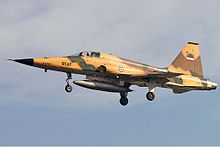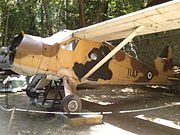Air force history of Iran
| Iranian Air Force |
|---|
 |
|
This article has multiple issues. Please help improve it or discuss these issues on the talk page. (Learn how and when to remove these template messages)
|
The history of the Iranian Air Force, currently known as the
Imperial era



| Imperial Iranian Air Force | |
|---|---|
The Imperial Iranian Air Force (IIAF) was a branch of the
A roughly 1946 order of battle for the Air Force can be found in Jane's Fighting Aircraft of World War II. Two regiments were both reported to be based near Tehran. After World War II, the IIAF began to slowly rebuild its inventory, with aircraft mainly supplied by the United States and Great Britain. A national, aerobatic display team was formed in 1958. Called "Golden Crown", and a part of the IIAF, this lasted until 1978.[2] Lieutenant General Nader Jahanbani is credited with establishing the Golden Crown and is generally considered the "Father of IIAF".
In the 1960s, the IIAF acquired 90 Canadair Sabre fighters from the RCAF, but they were flipped over to the Pakistan Air Force.
In the 1960s and 1970s, the air force was used as part of a joint, aerial espionage programme of Iran and the United States, against the former Soviet Union. This was in two parts, known as Project Dark Gene and Project Ibex.[3]
The IIAF deployed aircraft to Oman in the 1970s, when Iran provided military assistance to that country, during the
In 1976, the Imperial Iranian Air Force responded to a UFO incident over the Iranian capital, Tehran.
Later in the 1970s, the IIAF became the only military force other than the
During this era, the United States instituted the "Spellout", "Peace Ruby" and "Peace Net" programmes to upgrade the air-defence system of Iran. As well as air defence radars, the network was linked using microwave and troposcatter communications networks.

After the 1979
Post-Islamic Revolution
The overthrow of the Shah in the Islamic Revolution of February 1979, was followed by changes to the organization of the Iranian military. The air force was renamed the
However, it lost most of its leading officers in the course of post-revolutionary chaos, as well as due to the prosecution of those considered as loyal to the Shah, pro-U.S. or elsewhere by the new government in Tehran. Its other personnel were also decimated by the purges, with many pilots removed or leaving the air force. This left the air force ill-prepared for the Iran–Iraq War.
Iran–Iraq War

A series of purges and forced retirements, as a consequence of the
Following a one-week-long counter-air campaign, and due to a critical situation on the ground in Khuzestan Province, the IRIAF was thrown into the land-battle, mainly in the areas of Khorramshahr, Ahvaz, and Dezful. Here, the IRIAF's performance surprised most informed observers, with air strikes against armour and supply columns. Due to heavy losses in troops and armour, Iranian air superiority and an interruption of supply systems, the Iraqis had to stop their offensive, and then became involved in extremely bitter land-battles against Iranian ground forces.

However, the IRIAF paid a heavy price for this success, losing dozens of its best pilots and aircraft in the period between September and December 1980. Although the readiness rates of the IRIAF significantly increased in the following months, its overall role and influence declined, as the clerical government searched to put the emphasis in fighting on the Islamic Revolutionary Guard Corps (IRGC) militias, but also attempted to develop a separate air arm for this service.
After the successful liberation of most Iranian areas captured by the Iraqis, in late spring 1982, the situation of the IRIAF changed completely. From an air arm that was offensive by nature, it was largely relegated to air defense and, relatively seldom, tasks of flying bombing attacks against targets of industrial and military significance inside Iraq. Simultaneously, the IRIAF had to learn to maintain and keep operational its large fleet of U.S.-built aircraft and helicopters without outside help, due to American sanctions. Reaching back on equipment purchased from the U.S.A. in the 1970s, the Iranians began establishing their own aerospace industry; their efforts in this remained largely unrecognized until recently.
However, the IRIAF was able to obtain limited amounts of spare parts and weapons for its American-made aircraft, when Iran was able to buy American spare parts and weapons for its armed forces, during the Iran–Contra affair. Deliveries came via Israel and later, from the USA.
From 1984 and 1985, the IRIAF found itself confronted by an ever-better organized and equipped opponent, as the Iraqi Air force—reinforced by deliveries of advanced fighter-bombers from France and the Soviet Union—launched numerous offensives against Iranian population centres, industrial infrastructures, powerplants, and oil-export hubs. These became better known as "The Tanker War" and "The War of the Cities". To defend against an increasing number of Iraqi air strikes, the IRIAF leaned heavily on its large fleet of F-14 Tomcat air superiority fighters. Tomcats were mainly deployed in defense of the strategically important Kharg Island (main hub for Iranian oil exports), and Tehran. Over 300 air-to-air engagements against IQAF fighters, fighter-bombers, and bombers, were fought in these areas alone between 1980 and 1988.
Confronted with the fact that it could not obtain replacements for equipment lost in what became a war of attrition against Iraq, for the rest of the conflict, the IRIAF remained defence-orientated, conserving its surviving assets as a "force in being". From mid-1987, the IRIAF found itself confronted also with U.S. Navy fighters over the Persian Gulf. A number of confrontations that occurred between July 1987 and August 1988, stretched available IRIAF assets to the limit, exhausting its capability to defend Iranian airspace against Iraqi air strikes.
Post Iran–Iraq War


Immediately after the end of the Iran–Iraq War, the IRIAF was partially re-built by limited purchases of
A Russian attempt to sell a large number of
Iraqi aircraft from the Persian Gulf War
Following an alleged agreement (no proof exists for it) between the regimes in Baghdad and Tehran, in February 1991 a significant number of Iraqi Air Force (IrAF) aircraft were evacuated to Iranian airfields, to avoid destruction in the 1991 Persian Gulf War. The agreement was for Iran to return them after the war, but the Iranians impounded these aircraft instead, claiming them as war reparations for the Iran–Iraq War.
The IRIAF has pressed into service all of the 36
Present

The exact current composition of the IRIAF is hard to determine, but estimates do exist. Due to the continuous spare parts shortages faced by the air force, a decision was made in the late 1980s to develop a local aerospace industry to support the air force.
In 2002, Iran with the co-operation of
Since then the country has also become self-sufficient in the manufacture of helicopters. The country claims that it is capable of producing the old U.S.
Notable pilots
Unlike many other nations with modern air forces, Iran was engaged in an intense and protracted war. The 8 year long conflict with
Inventory 1920–1979
Gallery
-
A Boeing 707 of the Imperial Iranian Air Force refuels a Boeing 747 of the IIAF.
References
- ^ Nassirkhani, Farhad (ed.). "IIAF History". Imperial Iranian Air Force. Archived from the original on 2019-12-05.
- ^ Alibabaie, Gholamreza (2004). History of Iranian Air Force. Tehran: Ashian. pp. 98–99. ISBN 964-7518-19-6.
- ^ "Project Dark Gene". 15 February 2009. Archived from the original on 24 September 2015. Retrieved 3 February 2011.
- ^ Fire in the Hills: Iranian and Iraqi Battles of Autumn 1982, by Tom Cooper & Farzad Bishop, Sept. 9, 2003 Archived 2014-08-22 at the Wayback Machine: Dead link
- ^ Arabian Peninsula & Persian Gulf Database: Iranian Air-to-Air Victories, 1982–Today, Sept. 16, 2003 Archived 2010-03-23 at the Wayback Machine: Dead link
- ^ Imperial Iranian Air Force: Samurai in the skies
- ^ Arabian Peninsula & Persian Gulf Database: Iranian Air-to-Air Victories, 1976–1981, Sept. 16, 2003 Archived 2010-03-23 at the Wayback Machine:Dead link
Bibliography
- Andersson, Lennart (July 1998). "Histoire de l'aéronautique persane, 1921–1941: La première aviation du Chah d'Iran" [History of the Persian Air Force, 1921–1941: The First Aircraft of the Shah of Iran]. Avions: Toute l'aéronautique et son histoire (in French) (76): 2–12. ISSN 1243-8650.
Further reading
- Deurenberg, Ruud (March–April 2001). "Round-Out: Iranian 'Open-Top' Hurricanes". Air Enthusiast (92): 77. ISSN 0143-5450.






























